The Blue Echoes are one of Michigan’s longest-lasting rock and roll bands. Formed in late 1957 in the state capital of Lansing, the group will celebrate its 60th anniversary as a performing unit in 2017. Inspired by the early recordings of Bill Haley And His Comets and others, Larry Palmiter formed a three-guitar unit with two of his classmates at Resurrection High School. Initially called The Echoes, they would quickly evolve into a band of slicked-back rockabilly cats who would release a half-dozen singles on record labels of their own design; predating the "do-it-yourself" mantra of 70's punk rock by almost twenty years.
Palmiter attended Resurrection, one of Lansing’s larger Catholic schools, from grade school through high school. His music teacher for all of those twelve years was Ursula Klein; and Palmiter credits her with being an important factor in his musical development. Klein taught Palmiter’s music appreciation classes in grades one through eight and in high school had him in choir. Klein taught him how to read music and also directed Parmiter in two Gilbert and Sullivan operettas at Resurrection, H.M.S. Pinafore and The Mikado. 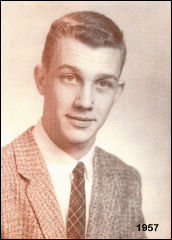 Larry Palmiter 1957
Larry Palmiter 1957
There was also a great deal of music in Palmiter’s home. His mother played the piano and had an extensive record collection. Larry developed an early interest in his mother’s big band records, and with a little help from mom, he began teaching himself to play piano and eventually guitar. By 1956, however, Palmiter had been bitten by the rock and roll bug and had started buying records by Haley, Elvis Presley, Fats Domino, Buddy Holly, and Little Richard.
Although he was singing in the church choir, Palmiter really wanted to perform rock and roll music. It started with Larry and his friends harmonizing on the doo wop hits of the day groups like the Del Vikings; and in late 1957 he formed a band called The Echoes with two other Resurrection High students. The original group was made up of three guitarists, with Tom Schmitt playing lead and Palmiter and Bob Devitri playing rhythm. Shortly thereafter, Bob Coscarelli added percussion when he joined on cocktail drum.
The cocktail drum is an unusual contraption that came into being after World War II, when jazz reigned supreme and the big bands were giving way to smaller combos. The instrument combines the bass drum and snare into one drum and requires the drummer to stand while playing. Although not commonly used in rock and roll, the cocktail drum was brought back into the spotlight in the 1980’s by Slim Jim Phantom of the Stray Cats. 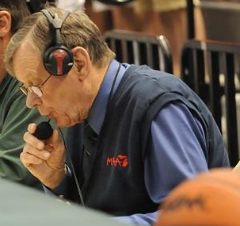 Erik "Erik O" Furseth
Erik "Erik O" Furseth
The Echoes first gained fame in their hometown by winning a city-wide Teens Against Polio talent contest in front of 3,000 teens at the Lansing Civic Center sponsored by Lansing’s leading Top 40 station, WILS. The event was hosted by Erik “Erik O” Furseth, the station’s leading DJ. Furseth had attended Michigan State University and played on the Spartan basketball team in the early 1950’s. He majored in communications and joined WILS after graduation. Furseth quickly became the # 1 disc jockey at the station, and “Erik O on the radio” was the voice of Lansing rock and roll radio during his tenure at WILS in the 1950’s and 1960’s. After leaving WILS, Furseth became the radio voice of Michigan State basketball from 1968 to 2002 and the voice of Spartan football from 1971 to 1998.
Furseth took a liking to the Echoes and the band started hanging out at the station, polishing up and even taping some of their songs. Having the station’s # 1 DJ with a large following in your corner was a big plus for the band. Besides playing at Erik O’s record hops, the Echoes also worked the hops hosted by the other WILS jocks: Hank Stevens, Gene Healy, and Dusty Walker. 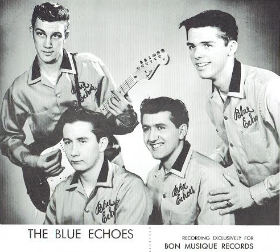 1958 (L to R) Larry Palmiter, Dino Richards, Bob Devitri, Roger Benham
1958 (L to R) Larry Palmiter, Dino Richards, Bob Devitri, Roger Benham
Along with playing the hits of the day, like “That’ll Be The Day” by The Crickets, and “Kisses Sweeter Than Wine” by Jimmie Rodgers, the Echoes also wrote and performed some original songs. The best of the early compositions was “Debbie”, co-written by Palmiter, Schmitt, and Devitri. The ballad, which had a similar tempo to “Young Love” the gigantic 1957 hit for both Sonny James and Tab Hunter, was a particular favorite of Erik O.
The band had another strong original as well with Parmiter’s “It’s Witchcraft”. With Erik O’s encouragement, Larry Palmiter became the driving force in trying to get the two songs on a vinyl 45. Before the band was able to record the tunes, however, they needed to replace their lead guitarist.
Tom Schmitt announced he was leaving the band immediately after graduation in the spring to join the Navy. He recommended Roger Benham, a guitarist from Holt, Michigan, who he had met and played with at the Norman English Studio and the International Music League competitions as his replacement.
Benham was born in Lansing in 1941, and he grew up idolizing cowboy singers Gene Autry and Roy Rogers and wanting to sing and play guitar just like his heroes. His parents were country music fans and supported his dreams by starting him on guitar lessons by the time he was eight. After trying several teachers, they settled on the Norman English Studios in Lansing that had a skilled staff and also scheduled a number of recitals each year for its students. 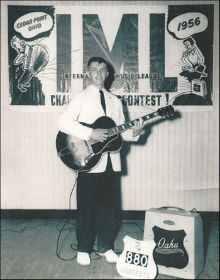 Benham at IML competition 1956
Benham at IML competition 1956
The Benham family built a new home and moved to nearby Holt, Michigan in 1955. Roger started attending Holt High School in his freshman year. He would go on to sing in the school choir for all four years and even perform the lead in the school’s production of the operetta, The Lowland Sea.
His big love, however, remained the guitar. By 1956, Benham’s father had purchased a Gibson electric/acoustic guitar. His first big public performance came that same year at the Sexton Auditorium in Lansing where he played and sang Elvis Presley’s latest hit, “Love Me Tender”.
1956 also saw Benham participating in national competitions on guitar through the International Music League. The Norman English Studios was affiliated with the IML and would bus its students to competitions as far away as Ohio. Benham won a world championship in his category at a competition in Berea, Ohio, in 1956. He played an instrumental titled “Louise” to win the award. It was a great honor, not only for young Benham, but also for his instructor, Ted Hagen, and the Norman English Studios.
Tom Schmitt was one of Benham’s guitar mates and fellow competitors. When he decided to leave the Echoes, he invited Benham to audition for the band. The group liked what they heard, and Benham joined in early 1958, just in time to record the band’s first single.
The Don Lee Studios was owned by Don Lee Bloomquist and located at his parents’ home on Eureka Street in Lansing. Bloomquist played the accordion and also gave lessons on the instrument. One of his students was Roger Benham’s younger sister, Marian. Bloomquist had done some experimenting with using echo in his studio and had used the effect on an accordion solo recording he made, aptly titled “Echo”. 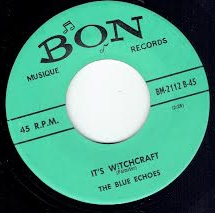
Palmiter, Benham, Devitri, and Coscarelli went into the Don Lee Studios and recorded two songs, with “Debbie”, a rockabilly ballad about a lost love, selected as the a-side. The flip, “It’s Witchcraft”, was a rocker featuring Palmiter’s hiccupping vocal, inspired no doubt by Buddy Holly. The song also included a hot guitar solo by Roger Benham. Don Lee employed some echo on both of the songs and ended up producing not only a classic rockabilly single, but also the first one to come out of Lansing.
When Bob Coscarelli decided to leave the band after recording the 45, the band had been getting a lot of gigs and had engagements almost every day. Coscarelli had a steady girlfriend and they were not seeing much of each other as a result of the band’s busy schedule. Although Coscarelli claimed he was leaving because he said he was “holding them back”, the other band members believed it was the girlfriend who instigated his departure. No one held his decision against him, however, and Coscarelli would continue to play with the band off and on during its early years. He was replaced on drums by Bob Richards from Holt.
Coscarelli came back to play an important 1959 show at the Lansing Civic Center hosted by radio station WCER from nearby Charlotte, Michigan. The event was hosted by DJ, and future MRRL Hall of Fame inductee, Dick Fabian. Fabian worked at WCER for four years before moving on to WKNX in Saginaw where he teamed with Bob Dyer to establish the Roll-Air Battle of the Bands in Bay City and turned the Saginaw Y.M.C.A. into the ‘Y A-Go-Go’ on weekends for teen dances and concerts in the 1960’s. 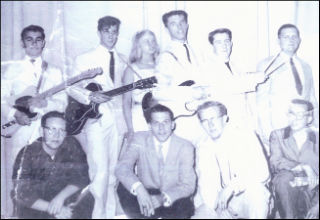 Top (L to R) Bob Coscarelli, Larry Palmiter, unknown, Roger Benham, Dino Richards, Carl Eastwick. Bottom (L to R) unknown, Dick Fabian, Dave Smith, manager Bill Thomas
Top (L to R) Bob Coscarelli, Larry Palmiter, unknown, Roger Benham, Dino Richards, Carl Eastwick. Bottom (L to R) unknown, Dick Fabian, Dave Smith, manager Bill Thomas
Because of the preponderance of ‘Bobs’ in the Blue Echoes, new member Bob Richards picked up the nickname ‘Dino’ as his band name. Richards’ middle name was Dean, but the spelling of his new nickname came from the lead character in the 1957 juvenile delinquent drama, Dino, starring Sal Mineo. Roger Benham recalled: “Dino was an awesome drummer. He could play anything and got into a lot of drum duals on the road. He usually won them too.” The drum duals were popular showdowns between the drummers of rival bands playing at the same gigs. The drummers would set up in front of the audience and each play a few solos. The winner would then be decided by audience applause.
Before the “Debbie/It’s Witchcraft” 45 was released, they learned that there was a band from the Detroit area that also had the name ‘The Echoes’ and were about to release a single of their own. To avoid any confusion, the Lansing Echoes decided to change their band name to ‘The Blue Echoes’, a moniker that Palmiter came up with from the title of a Chet Atkins’ recording titled “Blue Echo”. 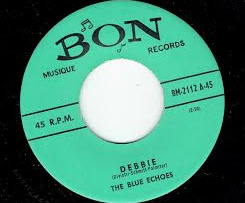
The Blue Echoes rehearsed regularly in the basements of their parents’ homes; and it was their parents who put up the money for the Bon Musique label and pressed 3,000 copies of “Debbie/It’s Witchcraft”, which were then released to radio stations for airplay and the public for sale. Erik O pushed “Debbie” hard on WILS; and it eventually reached # 1 in the Lansing area and stayed on the station’s chart for 14 weeks. Benham was a senior at Holt High when the song hit in early 1959 and remembered how cool it was that the school’s audio-visual club played the song every noon hour for months over Holt’s P.A. system.
Benham recalls this time period with great fondness. He was part of the car culture in high school, with its leaded-in trunks and hoods, leg pipes, dual exhausts, chopped tops, and coon tails being the trends of the day. He was driving a ’55 Chevy as he “cruised the gut” up and down Washington Avenue in Lansing, looking for parties and girls. The “gut” was a section of Lansing that included a host of teen meeting places and hangouts including Kupi’s, The Trio, and Sully’s Drive-In. Benham remembers one particular night when he and a buddy were trying to deal two girls in another car while driving down Washington. The police pulled over both cars and ticketed the drivers for “going too slow” on the thoroughfare.
The 1950s was also a time when many people believed that rock and roll was the “devil’s music” and one of the primary causes of juvenile delinquency. One such person was Benham’s minister at the Holt Baptist Church. Despite the fact that Benham sang and played guitar at the church each Sunday, accompanied by his sister Marian on accordion, the minister knew he was playing rock and roll and gave him such a hard time that Benham quit the church and began attending the Methodist Church in Holt.  The Blue Echoes
The Blue Echoes
The success of “Debbie” led to it being picked up by Arc Distribution in Detroit. The company arranged for a promotional trip to the Motor City where the band met DJs from various Detroit stations and appeared at several high school dances. Arc also arranged a similar promotional trip to Chicago for the band. Erik O used his contacts to try and get the Blue Echoes a deal with Decca Records, but it fell through and “Debbie” remained a regional hit in Michigan.
In 1959, the Blue Echoes hired Bill Thomas of Detroit to be their agent/manager. The band had met Thomas at the Central Michigan Teen Club in Grand Ledge. The club was located upstairs above the Kroger Store and the record hops were hosted by Dick Fabian of WCER. The dances were very popular and drew teens from all around the area before they were shut down by city officials because of overcrowding.
Thomas met with the band’s parents, had some big plans, and was interested in investing some of his own money in return for a percentage of their earnings. He convinced them that he could revive “Debbie”, get it or their next single distributed nationally, and possibly get the band booked on American Bandstand and the Ed Sullivan Show. 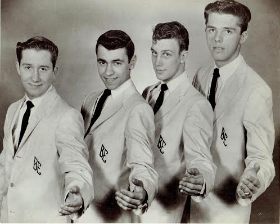 (L to R) Dino Richards, Bob Coscarelli. Larry Palmiter, Roger Benham
(L to R) Dino Richards, Bob Coscarelli. Larry Palmiter, Roger Benham
“Debbie” and the band’s association with Arc Distribution and Bill Thomas did help the band book bigger gigs in the Detroit area. The largest was at the Michigan State Fairgrounds Coliseum where they shared the stage with national recording artists Neil Sedaka, Carl Mann, Bobby Rydell, and Carl Dobkins Jr. Another important Detroit gig was at the Light Guard Armory on 8 Mile where they appeared with Jack Scott, the Royal Teens, and Dickey Lee.
Besides playing shows with Johnny and the Hurricanes, who often appeared in Michigan, the Blue Echoes also played at large record hops with important regional acts such as Danny Zella and His Zell Rocks from Detroit, the Ski Brothers from Pontiac, and Mack Vickery from Adrian. The band even shared the stage at a teen dance with a very young Stevie Wonder before he achieved stardom at Motown.
The Blue Echoes appeared with the Crew-Cuts, a Canadian vocal group that had several hits in the 1950’s, at the Ingham County Fair. The Crew-Cuts turned them on to their publishing company, Asbury Music B.M.I., and the Blue Echoes would go on to use the publisher for all the rest of their original recordings.
The band recorded their second single in 1959 on their new Glisten label after signing with Asbury Music. Both songs were written by Larry Palmiter. “Cool Guitar” was the a-side and the stronger of the two, an uptempo rockabilly tune featuring a nice guitar solo. The flip, “Teddy Bear Love”, was a teen break up ballad in the same vein as “Debbie”; only this time it was the girl in the song who was left for another. The band recruited a Lansing group called The Fidelitones to do the backing vocals on both songs, giving the production of the new single a more radio-friendly sheen. 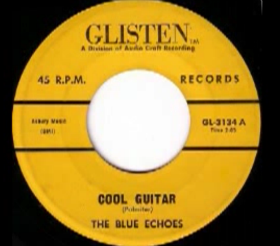
Unfortunately, the “Cool Guitar’ single didn’t do as well as “Debbie”. WILS didn’t back the Blue Echoes’ new release like they did the band’s debut. It was a modest regional success, however, and DJ Lee Lyons of Grand Rapids’ WMAX told the band that "Teddy Bear Love" should have been a national hit.
Meanwhile, the Blue Echoes’ relationship with their new manager was becoming strained. They decided to go with Thomas because he seemed very sincere, said he could bolster the band's career, help with their funding, and they would be his only client. Thomas set up the band's schedule, booked the gigs, and he worked with Arc in lining up shows in the Detroit area. But he also laid down the law for the band on the road. He had a curfew and strict rules, including one that band members couldn’t date girls during the week.
The band played mostly dances and record hops in Michigan during Thomas’ tenure as manager. Teen clubs were in their infancy during this time but the Blue Echoes did play at the Music Box, a dance hall located at the eastern end of Houghton Lake in Prudenville, Michigan.
Thomas wanted to take “Cool Guitar” national, but nothing worked out and they didn’t sign a distribution deal or a recording contract with a major label. Things had begun to slow down for the band and none of Thomas' plans for televison appearances by the Blue Echoes had come to fruition by the summer of 1960. When the band's fortunes began to dip as a result, Roger Benham decided to leave the group and enroll at Michigan State for the fall semester. The band had lost confidence in their manager at that point, and they parted ways with Bill Thomas. 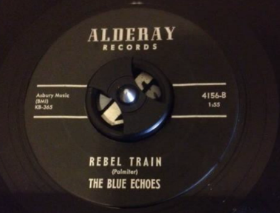
After splitting with their manager, the remaining band members recorded the first of what would be three singles on their new Alderay record label. The a-side was the band’s cover of the George Gershwin classic “Summertime”, featuring the sax of Palmiter’s friend, Dave Allen; but it’s the b-side, the Palmiter-penned surf rock instrumental “Rebel Train” that holds the most interest to record collectors today. With its big guitar sound and honking sax, the instrumental is similar to the Rockin’ Rebels’ big hit, “Wild Weekend”.
During this period, Palmiter and a friend, sax player Ron Good, traveled to Florida for a vacation. They stayed with Good’s uncle and went out deep sea fishing on his boat. One night during their stay, Palmiter and Good sat in with a band at a nightclub in Cocoa Beach. The owner was very impressed with their musicianship and told them he would hire them for his club if they got a band together. 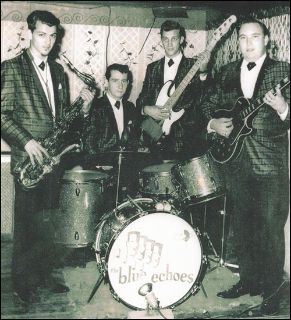 Blue Echoes 1961 (L to R) Ron Good, Dino Richards, Larry Palmiter, Jimmy Black
Blue Echoes 1961 (L to R) Ron Good, Dino Richards, Larry Palmiter, Jimmy Black
When they got back to Lansing, they called both Bob Devitri and Roger Benham to go back to Florida but both turned them down. So they put together a new version of the Blue Echoes with Larry Palmiter on bass guitar, Ron Good on sax, Dino Richards on drums and Jimmy Black on lead guitar. The band went on the road to Florida in late 1960, first playing at a nightclub called Joey’s Twist Lounge at the Satellite Motel in Cocoa Beach. Eventually they would play up and down the beach as well as in Orlando. They also got jobs in Georgia and Alabama.
By 1962, Roger Benham had married and was working to support his wife and family as well as taking classes at MSU. To pick up extra money on the weekends, Benham put together his own Lansing band, The Stratocasters, named after the 1959 Strat that he played on stage. After seeing the success his former bandmates had playing in Florida, he brought the Stratocasters down there to play a series of dates.
The next Blue Echoes’ single on Alderay was the classic “O’ Misery”, which was written by Larry Palmiter. The record label stated that the song was “from the Peppermint Cane Lounge in Cocoa Beach, Florida” and was encased in four peppermint-striped candy canes. Palmiter’s growling lead vocal brought to mind some of Conway Twitty’s early rockabilly recordings, and it is one of the Blue Echoes’ best 45s. The flip was a cover of an old Vaughn Monroe hit from the 40’s called “The Maharajah of Magador” that Palmiter had first heard from his mother’s record collection. Palmiter updated it to include references to the twist dance craze of the early 60’s, and made it an interesting novelty recording for that time period. 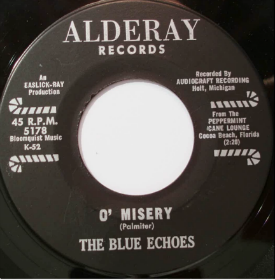
The band’s final single on Alderay was issued in early 1965. The A-side was a cover of “Tossin’ and Turnin’”, the # 1 hit by Michigan artist Bobby Lewis in 1960. Their version has a definite British Invasion sound, which was interesting in light of the fact that both the Blue Echoes as well as British bands like the Beatles and Rolling Stones were both heavily influenced by early rockabilly artists like Elvis Presley, Carl Perkins, and Buddy Holly. The flip was a cover of “Red Sails In The Sunset”, done in the same style as the earlier Fats Domino hit. Ed Emery played drums on this 45 with Dino Richards switching to bass and Palmiter to keyboards.
Roger Benham rejoined the Blue Echoes, replacing Jimmy Black, following the band’s last Alderay recording. The band was no longer playing in Florida and was now firmly entrenched in playing the bars in Lansing along with regular gigs in taverns in the surrounding area such as the Alpine Bar in Charlotte and the Blinker Light in Potterville.
One of Lansing’s most popular bands during the 60’s and early 70’s was The Woolies. The group had enjoyed a major regional hit with their cover of Bo Diddley’s “Who Do You Love?”. The song also squeaked into the Billboard Hot 100 at # 95 in early 1967. Although the Woolies failed to record any more hits, the band made a name for themselves as Chuck Berry’s backup band of choice for many of the dates he played in the Midwest. By the early 1970’s, the Woolies had their own studio in Lansing and recorded a Chuck Berry album there in 1971 titled “San Francisco Blues”.
The Blue Echoes had still not given up their dream of making it big in 1972 when they recorded what was to be their final single at the Woolies’ studio in Lansing. Benham was quoted in The State Journal in May of ’72: “Sure we’d like to make it big – get a piece of the action” Benham said. “It’s a rough business, but we love it. I guess that’s why we’re still in it, and sometimes you get lucky. It’s a lot tougher to make it now than it was fifteen years ago” Benham explained. “There are a lot of excellent young rock groups who never get heard because of the cost of cutting a record.”
The Lansing newspaper had done the story on the Blue Echoes because they had just released their new single, the uptempo ballad “Man From Nowhere” and the rocking “South San Francisco”. Both songs were written by Palmiter and put out on their very own 'A New Man' label. The band was encouraged because both sides were earning airplay on local stations. Although the Blue Echoes stated in the article that they were planning guest appearances throughout Michigan and surrounding states to promote the single, the hoped-for hit failed to materialize. 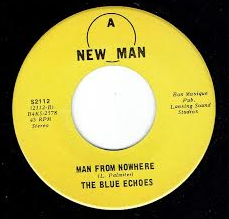
The band soldiered on; but after Ron Good and Dino Richard left, it looked as if the Blue Echoes might come to an end. It was then that Craig Benham, Roger’s son, joined as the drummer. Craig had learned how to play the drums while working in the music store that his father had operated in Lansing from 1967 to 1979. Craig had then played in a number of high school bands and had sat in on occasion with the Blue Echoes before joining full time.
Craig played with the band until 1994 when he left music in the wake of the tragic death of his girlfriend. After grieving for a number of years, during which his father and Larry Palmiter played as a duo, Craig rejoined the Blue Echoes in 2000 and has stayed with the band ever since.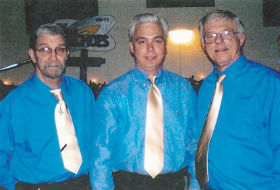 Current Blue Echoes (L to R) Larry Palmiter, Craig Benham, Roger Benham
Current Blue Echoes (L to R) Larry Palmiter, Craig Benham, Roger Benham
In 2012, Larry Palmiter and Roger Benham were contacted by the Rockabilly Hall of Fame. After an interview with the organization, Parmiter and Benham, along with deceased original members Dino Richards and Bob Devitri were inducted into the Rockabilly Hall. In recognition of their honor, Life In Lansing did a video interview with the surviving band members and sponsored an induction show at the Walnut Hills Country Club in East Lansing.
In 2016, the Blue Echoes received the most votes in the annual balloting for induction into the Michigan Rock and Roll Legends online Hall of Fame. Also in 2016, the band’s photo and some of their early recordings were prominently featured in the mammoth 10 CD collection from Europe titled “The Michigan Box: 1950s & 1960s Oddball Labels”.

